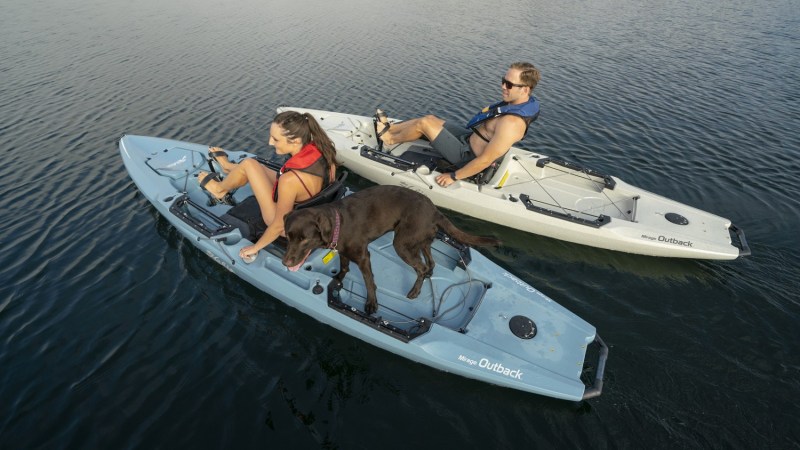Hobie has been making surfboards and catamaran sailboats since the ’50s. The company has built an entire lifestyle around playing on the water, continually re-inventing ways to do it.
In 1997, Hobie put together the first MirageDrive, a propulsion system for using your legs to drive fins under the boat. The pedals move like a recumbent bike, flapping the fins underneath back and forth like penguin wings. Since then, Hobie has updated the MirageDrive to be faster and easier to use, adding it to kayaks, sailboats, and even paddle boards.
Here are five recent changes to the Hobie lineup of boats and boards.
New Mirage Outback – $2,799
Hobie kayaks have long been popular with anglers. The stable platform and maneuverability make it easy to spend hours on the water and the MirageDrive made it even easy to get around using your legs, keeping your hands free for fishing and holding cold beverages. For 2019, the Outback is getting a big update.

A quieter, faster hull and wider, 34-inch deck now turn the Outback into the ultimate fishing kayak. MirageDrive 180 powers the new Outback, letting you flip the fins with a pull of a cord and pedal full speed in reverse. ARC cranks adjust the leg length with the push of a button. Turbo fins are larger than their ST companion, pushing the Outback through the water faster. On the bottom, the Guardian Transducer Shield keeps your fish finder transducer tucked up safely in the boat when beaching or car-topping. Plenty of storage and mounts front and back hold fishing gear.
Mirage i11S – $2,399
If you don’t have space for a 13-foot kayak on your car or in your garage, just get an inflatable and blow it up like a balloon. The Mirage i11S is a pedal-driven kayak with a rudder and comfortable Vantage CTi seat but it’s inflatable. The suitcase-sized roller-bag holds all the accessories and is far easier to store and transport than a rigid-hull.

The i11S inflates with a pump in about 10 minutes. Attach the chair, MirageDrive pedals, and rudder and it’s ready to go in the water after being in the back of a hatchback. There’s storage on the front and back for drinks and gear. The chair pops off to use on the beach. Fully rigged, it weighs a little bit more than a balloon at about 64 pounds, but this balloon can carry 400 pounds of rider and gear.
Mirage Eclipse 12 – $1,899
The small muscles in your arms get tired after paddling a lot. The big muscles in our legs are better suited to putting in the miles, so Hobie put a MirageDrive in a paddle-board to make it a pedalboard. Just hold on to the handlebars, pump the pedals like a StairMaster, and you’ll be cruising farther and faster. We saw the Eclipse at Surf Expo earlier this year.

Steering is done with the levers on the handlebars (squeeze right to go right). The bars adjust up and down for taller riders and kids. The rudder kicks up if you hit anything. For heading home, the handlebars, MirageDrive fins, and rudder pop off. The Eclipse comes in 10-foot, 5-inch and 12-foot lengths, holding 225 pounds and 275 pounds respectively.
Compass Duo – $2,999
To take a friend or kids out on the boat, grab the Compass Duo for two people. The comfy Vantage seats are adjustable in four different ways and both have MirageDrive pedals. Steering is in the back and there’s space for gear on the stern and bow. If you still need more space, toss the friend and pack more on the front seat.

As with all the Hobies, there’s tons of space for mounting accessories. H-Tracks beside each seat can mount fish-finder consoles, GPS units, or just cup-holders. Two rod holders are built in behind each seat. The customizable H-Create fits in the stern storage area — there’s even a mount for a sailing mast.
Tandem Island – $6,899
Pedaling is much for efficient than paddling, but sailing is more efficient than both. The Tandem Island is a two-person MirageDrive kayak with two pontoons for stability and a 90-square-foot sail. When there’s wind, roll out the sail and fly. When there’s not, cruise at 6 miles per hour with the pedals.

The Tandem Island has seats for two but with the nets between the pontoons and a 600-pound capacity, there’s space for more. For a quick kayak, the pontoons and sail can be left at home.


